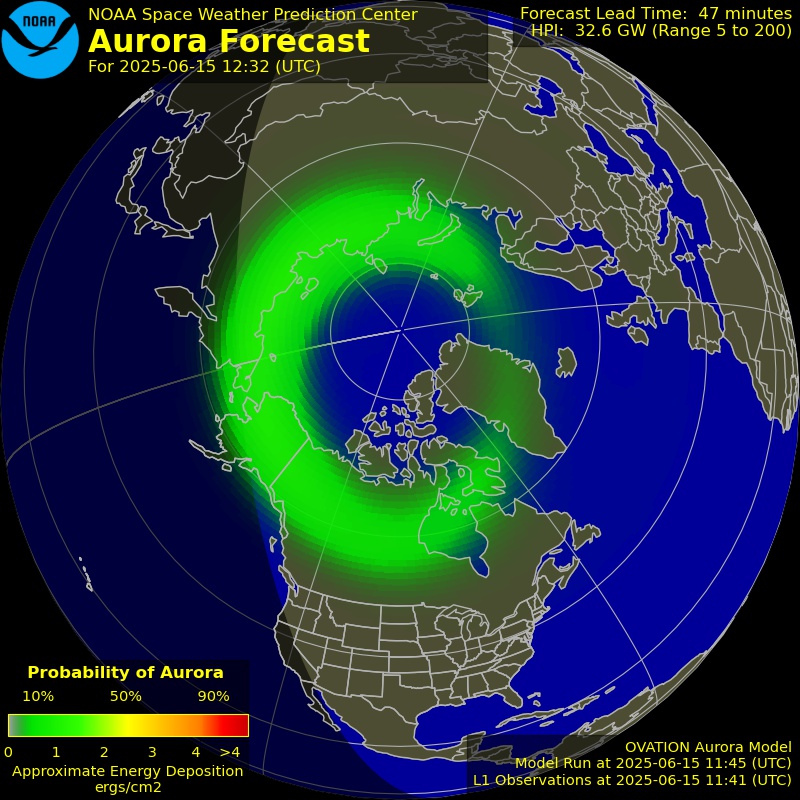|
Northern Hemisphere 
|
Southern Hemisphere 
|
This is a short-term forecast of the location and intensity of the aurora. This product is based on the OVATION model and provides a 30 to 90 minute forecast of the location and intensity of the aurora. The forecast lead time is the time it takes for the solar wind to travel from the L1 observation point to Earth.
The two maps show the North and South poles of Earth respectively. The brightness and location of the aurora is typically shown as a green oval centered on Earth’s magnetic pole. The green ovals turn red when the aurora is forecasted to be more intense. The sunlit side of Earth is indicated by the lighter blue of the ocean and the lighter color of the continents. Aurora can often be observed somewhere on Earth from just after sunset or just before sunrise. The aurora is not visible during daylight hours. The aurora does not need to be directly overhead but can be observed from as much as a 1000 km away when the aurora is bright and if conditions are right.
The aurora is an indicator of the current geomagnetic storm conditions and provides situational awareness for a number of technologies. The aurora directly impacts HF radio communication and GPS/GNSS satellite navigation. It is closely related to the ground-induced currents that impact electric power transmission.
For many people, the aurora is a beautiful nighttime phenomenon that is worth traveling to arctic regions just to observe. It is the only way for most people to actually experience space weather.
These links provide a discussion of the aurora phenomena and tips for the best opportunities to view aurora at various locations around the world.
The OVATION (Oval Variation, Assessment, Tracking, Intensity, and Online Nowcasting) model is an empirical model of the intensity of the aurora developed at the Johns Hopkins University, Applied Physics Laboratory by Patrick Newell and co-workers1. The model uses the solar wind velocity and interplanetary magnetic field measured at the L1 orbit position at 1.6 million km (1 million miles) upstream from earth as input and calculates three types of electron precipitation and the proton precipitation which strongly correlate with the aurora. An estimate of aurora viewing probability can be derived by assuming a linear relationship to the intensity of the aurora. This relationship was validated by comparison with data from the Ultraviolet imager (UVI) instrument on the NASA Polar satellite(2).
On occasion, the input solar wind data are either contaminated or unavailable. In those instances, an alternative estimate of the solar wind forcing, based on the current Kp geomagnetic index is used to drive the OVATION model. When this occurs, there is no forecast lead time.
For more information on the OVATION model and aurora products, see:
- Newell, P. T., T. Sotirelis, and S. Wing (2009), Diffuse, monoenergetic, and broadband aurora: The global precipitation budget, J. Geophys. Res., 114, A09207, doi:10.1029/2009JA014326(link is external).
- Machol, J. L., Green., J. C., Redmon, R. J., Viereck, R. A., Newell, P. T., (2012), Evaluation of OVATION Prime as a forecast model for visible aurorae, Space Weather, 10, 3, doi.org/10.1029/2011SW000746
In 2009, Newell et. al., developed the OVATION model.
In 2011, NOAA (NCEI and SWPC) developed a real-time version of the OVATION model to forecast the location and intensity of the aurora. Machol and Redmon (NCEI) developed the real-time ovation model. Viereck (SWPC) implemented the model and developed the graphical products to run in realtime to create aurora forecasts.
In 2013, Newell upgraded the OVATION Prime model so that it would more accurately capture large geomagnetic storms. The original model, based solely on DMSP data, was only reliable to Kp of 7. By adding data from the NASA TIMED GUVI instrument, Newell et al., were able to expand the model to include the larger storm values of Kp of 8 and 9.
In 2016, NOAA SWPC shared the operational OVATION code (written in IDL) with the UK Met Office in the UK. The UK Met Office converted the OVATION model from IDL to Python.
In 2020, NOAA SWPC implemented the new version of the OVATION Prime model into operations. This version has been dubbed OVATION 2020.
The Auroral Forecast product is based on the OVATION Prime model developed by P. Newell at the Johns Hopkins, Applied Physics Laboratory.
The latest 24 hours of image frames comprising the Northern and Southern hemisphere loops (with time-tagged file names) are available: Northern, Southern
The most recent Northern and Southern Hemisphere images (with static file names) are available: Northern, Southern
Auroral data in a grided format for the entire Earth is available in compressed JSON format: The latest JSON file is available as well.
The Hemispheric Power Index, an estimate of the total auroral energy input at each pole, is available in ASCII format: latest HPI